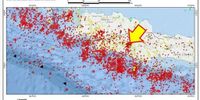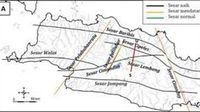In a startling reminder of Indonesia's seismic volatility, a magnitude 4.1 earthquake struck Bogor, West Java, on Thursday night, April 10, 2025, at approximately 22:16 WIB. The quake, which lasted for several seconds, was felt in surrounding areas, including Depok, causing panic among residents. According to the Meteorology, Climatology, and Geophysics Agency (BMKG), the earthquake was classified as a shallow crustal event, occurring at a depth of just 5 kilometers.
The epicenter of the earthquake was pinpointed at coordinates 6.62 LS and 106.8 BT, located roughly 2 kilometers southeast of Bogor's city center. Daryono, the Director of Earthquake and Tsunami at BMKG, explained that this seismic activity was triggered by the Citarik Fault, a known active fault line in the region.
“The earthquake was characterized by a sinistral strike-slip mechanism, which aligns with the Citarik Fault’s known properties,” Daryono stated. This fault has been active since the Middle Miocene, approximately 15 million years ago, and stretches about 250 kilometers from the Indian Ocean to the Java Sea. It is divided into three segments—southern, central, and northern—each exhibiting different seismic characteristics.
In response to the earthquake, Vice Minister of Home Affairs Bima Arya Sugiarto emphasized the importance of coordination between local authorities and BMKG to monitor earthquake-prone areas. “It’s crucial for regional heads to communicate with BMKG to identify vulnerable spots,” he said, highlighting that some areas, including Bogor, are particularly challenging to predict seismic activity.
Bima Arya, who felt the earthquake at his home, described the experience as unprecedented. “I jumped out of my house and waited outside for an hour. This has never happened before,” he recalled. He urged local officials to implement mitigation strategies and keep residents informed about potential risks, especially as Gunung Salak and Gunung Gede, both nearby volcanoes, are showing signs of increased activity.
Gunung Salak and Gunung Gede are two of the seven active volcanoes in West Java. Bima's warnings reflect growing concerns over volcanic activity in the region, which could compound the risks associated with seismic events. “We have just learned that Gunung Salak and Gunung Gede are now showing tendencies of activity. This must be monitored closely,” he cautioned.
BMKG’s analysis confirmed that the earthquake was not volcanic but tectonic in nature. Daryono explained that the seismic waves recorded during the event indicated strong shearing typical of tectonic earthquakes when faults rupture and release energy. “The evidence shows that the Bogor earthquake is a tectonic event rather than one caused by volcanic activity,” he added.
Moreover, the Geological Agency of the Ministry of Energy and Mineral Resources has assured the public that Gunung Gede's activity level remains normal at level 1. They continue to monitor the volcano closely, providing updates as necessary. “If there are any changes regarding Gunung Gede’s activity, we will inform the public,” the agency stated.
The Citarik Fault is not the only fault line in West Java with the potential to cause significant earthquakes. Other active faults include:
- Garsela Fault: Stretching 42 kilometers from southern Garut to southern Bandung, this fault has shown considerable seismic activity since 2008.
- Cimandiri Fault: Approximately 100 kilometers long, it is known for causing the devastating Cianjur earthquake in November 2022, which resulted in over 600 fatalities.
- Lembang Fault: This 30-kilometer fault is located north of Bandung and has been monitored since 1963.
- Baribis Fault: Running from Purwakarta to the Baribis hills in Majalengka, it has a history of causing significant earthquakes.
As the region grapples with the aftermath of the quake, local authorities are urged to take proactive measures to enhance community preparedness. Bima Arya has called for an active approach to disaster risk management, emphasizing that communication with BMKG is vital for effective response and mitigation strategies.
In light of the recent seismic activity, residents are advised to stay alert for aftershocks and to follow guidance from local disaster management agencies. The Geological Agency has reassured the public that there is no immediate threat of tsunami or significant aftershocks from this event.
In summary, the earthquake that shook Bogor serves as a stark reminder of Indonesia's geological dynamics. With several active faults present, the region remains susceptible to seismic events, necessitating ongoing vigilance and preparedness among both authorities and residents.







